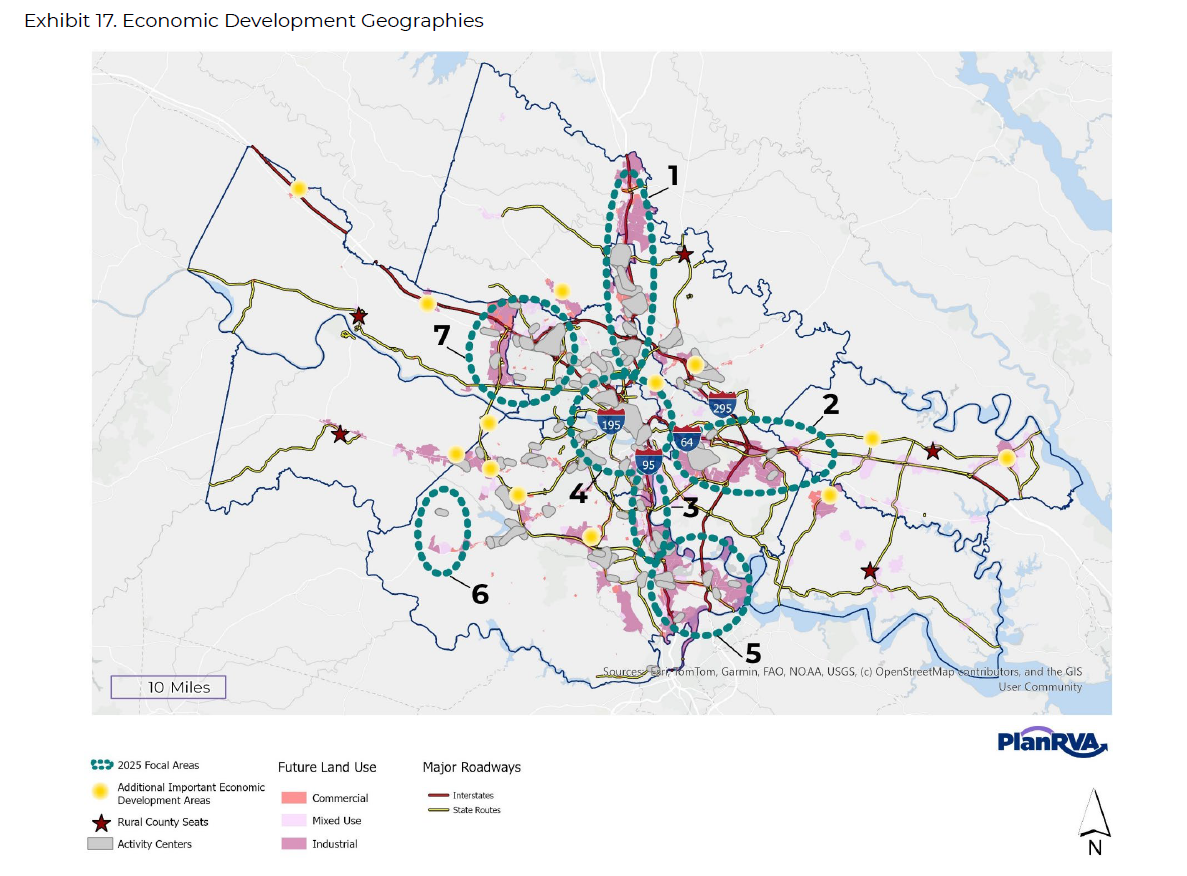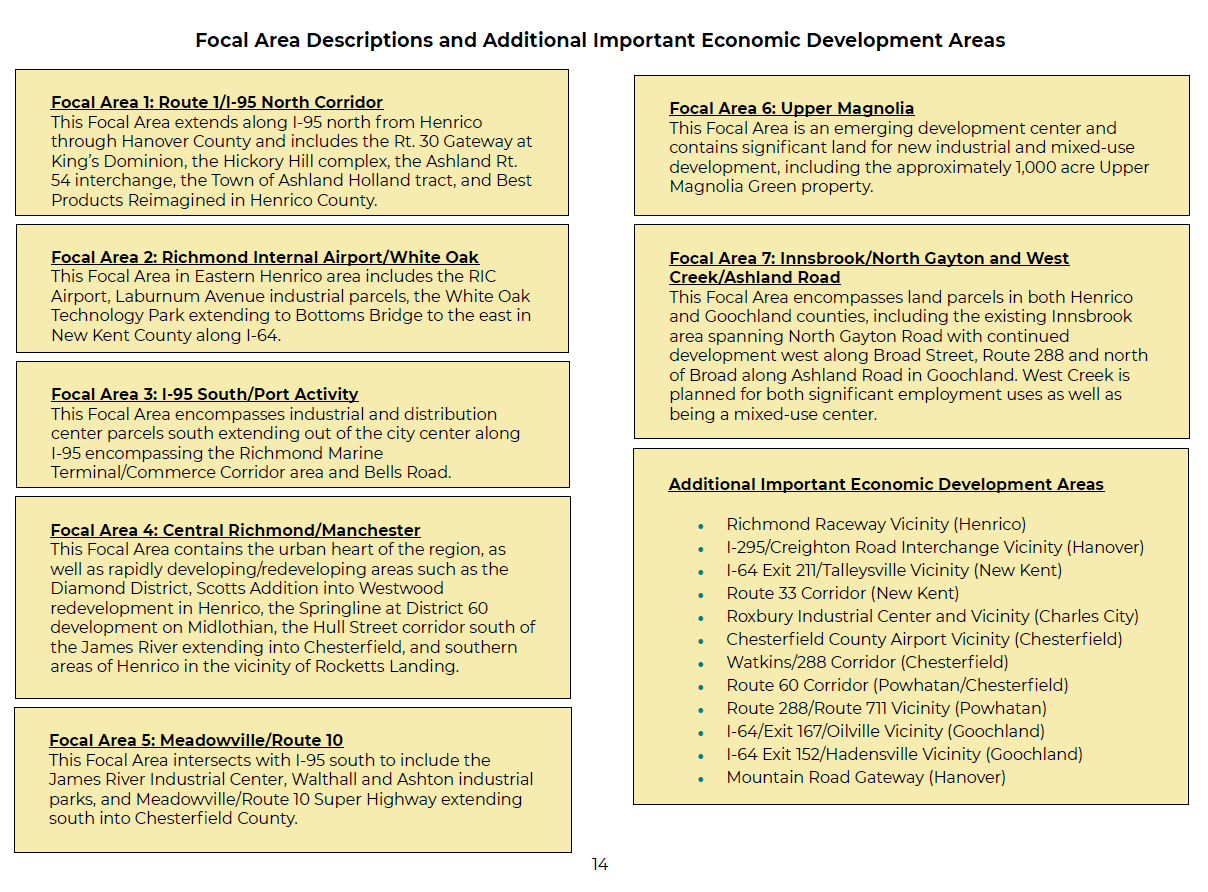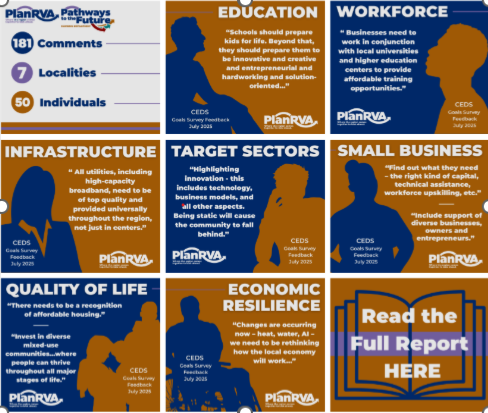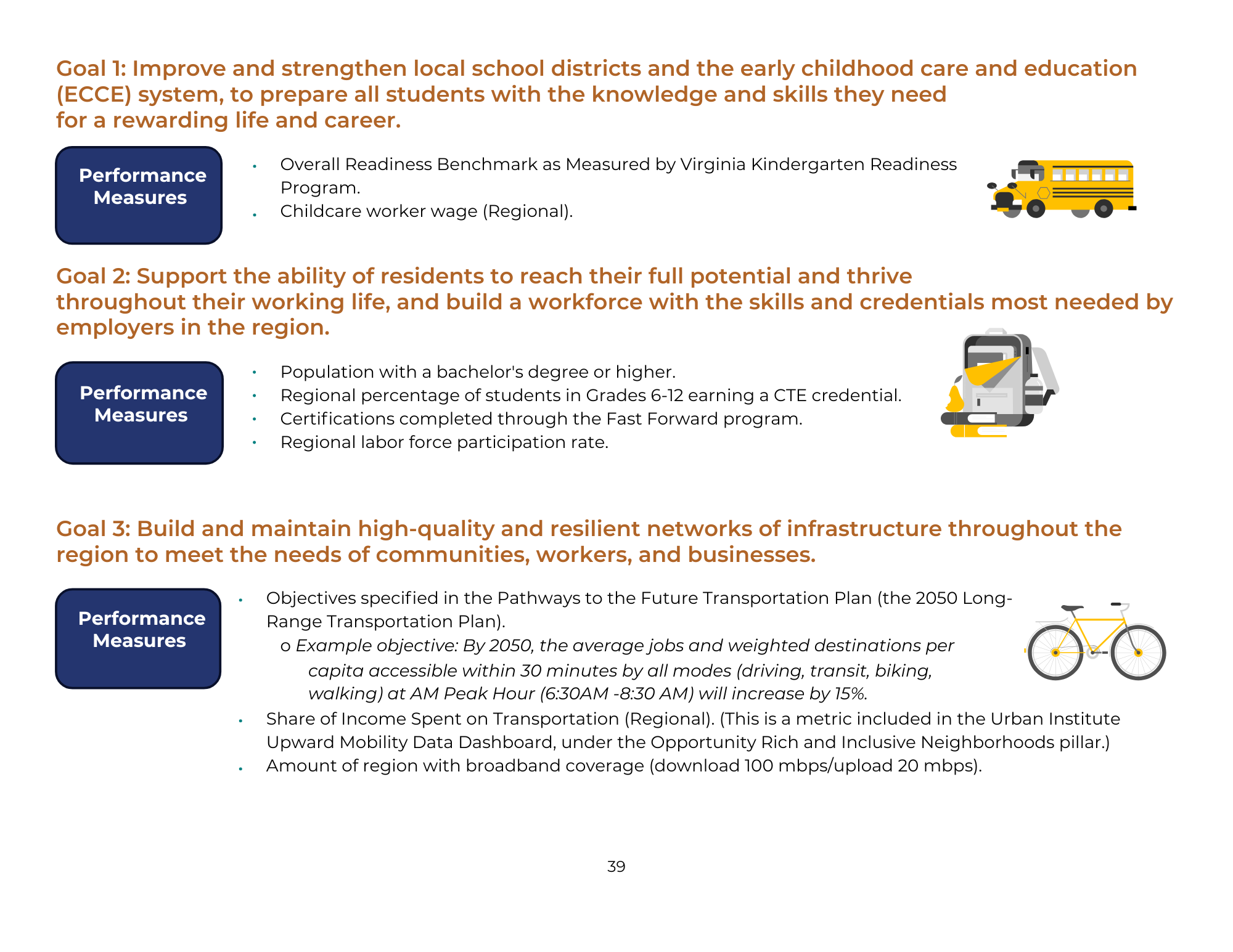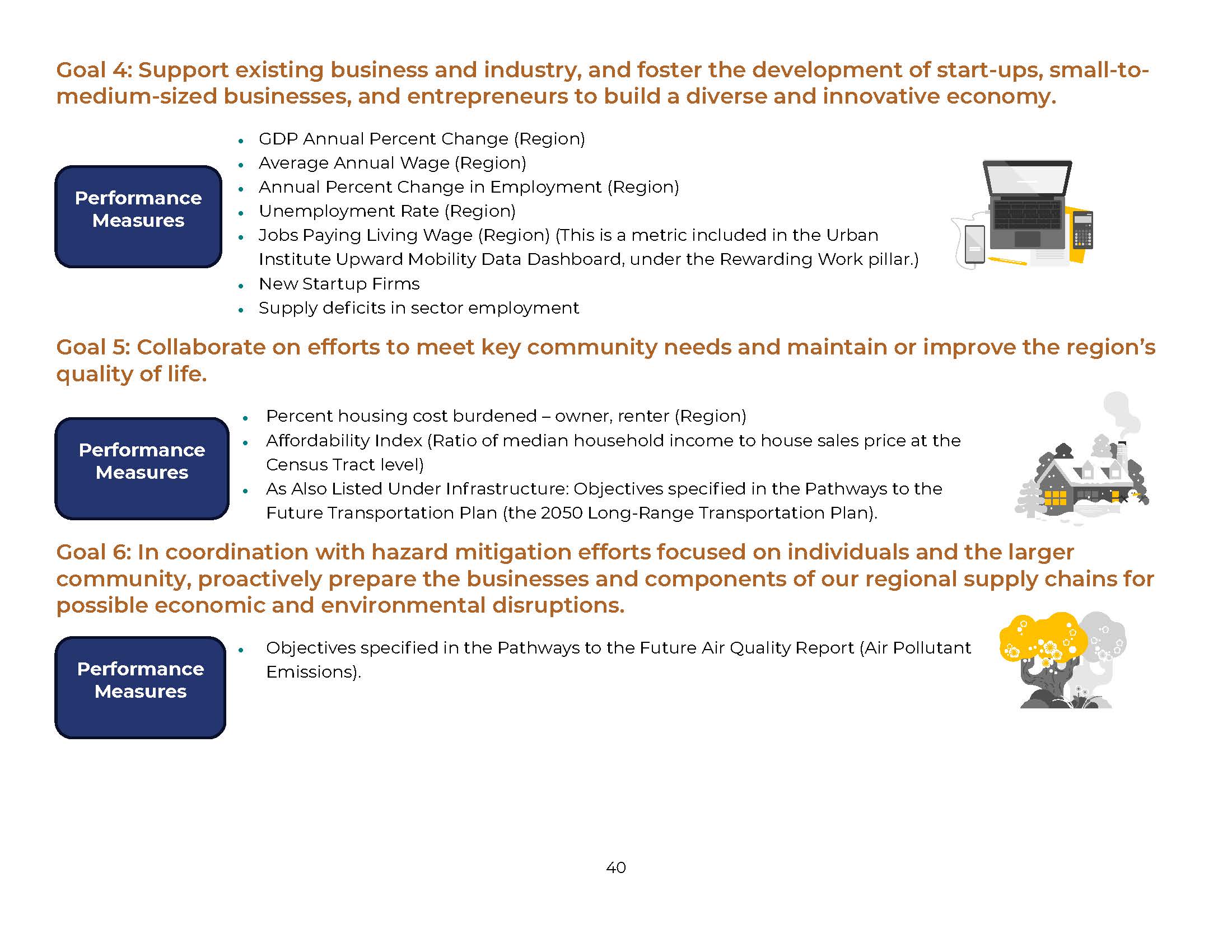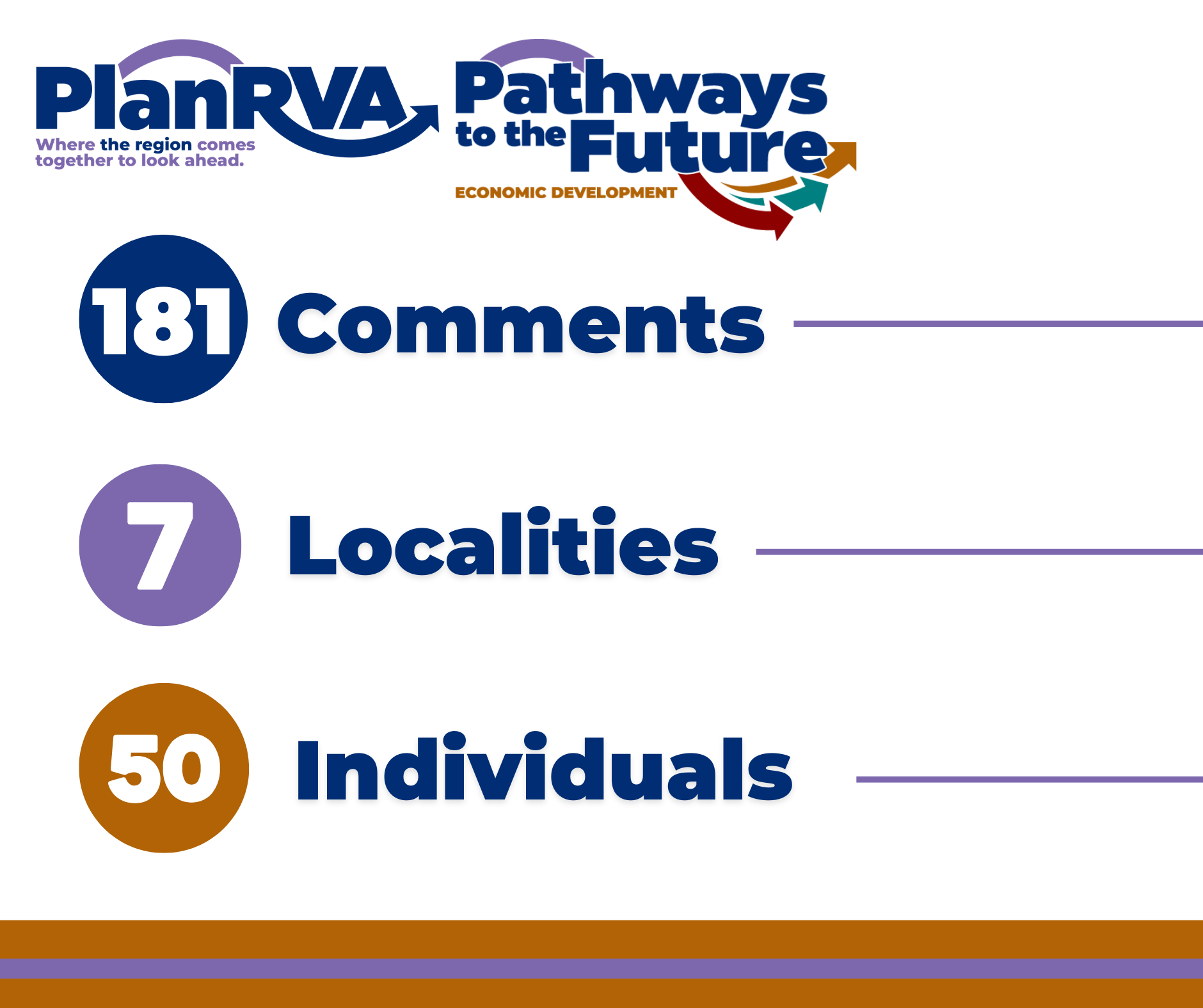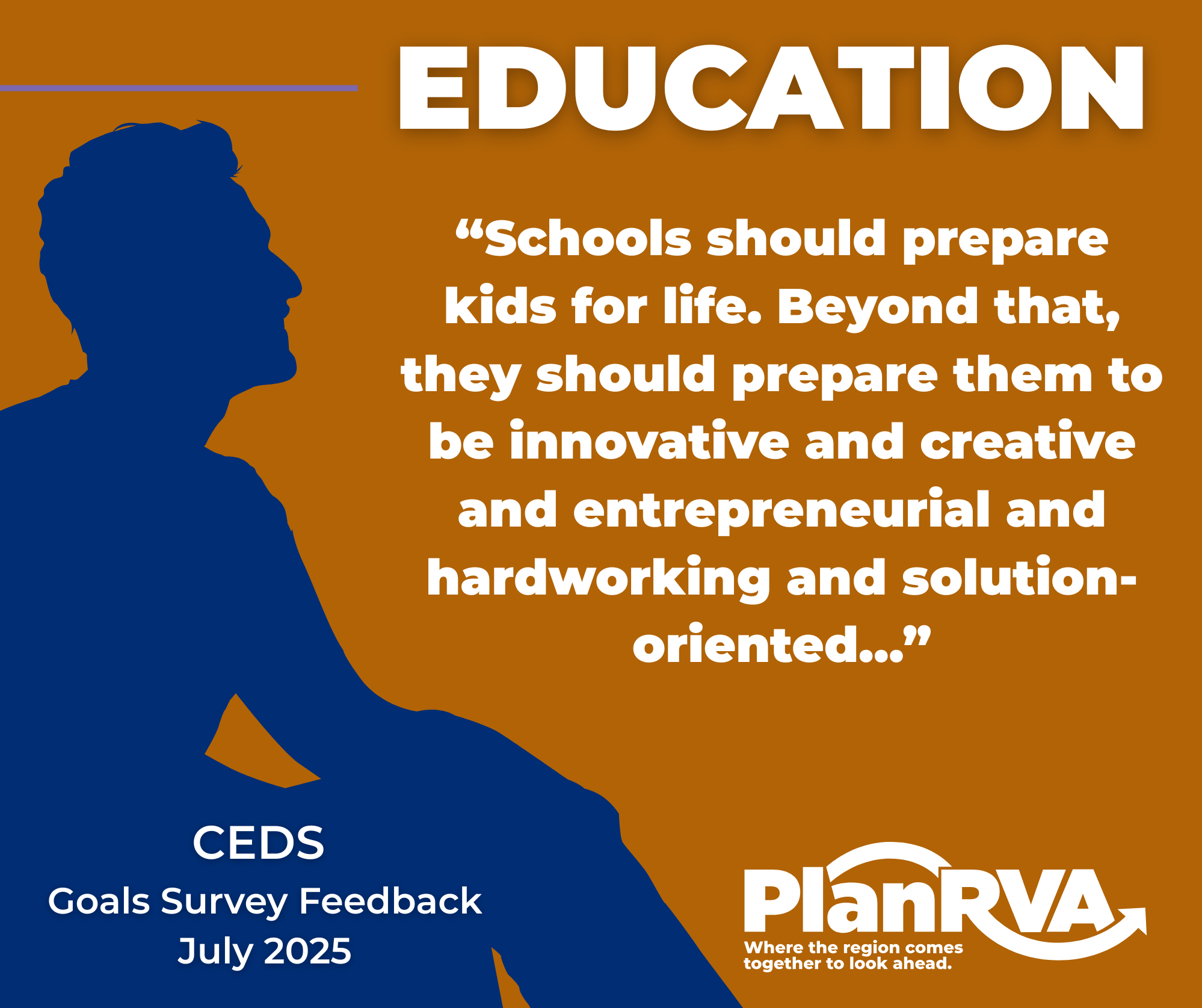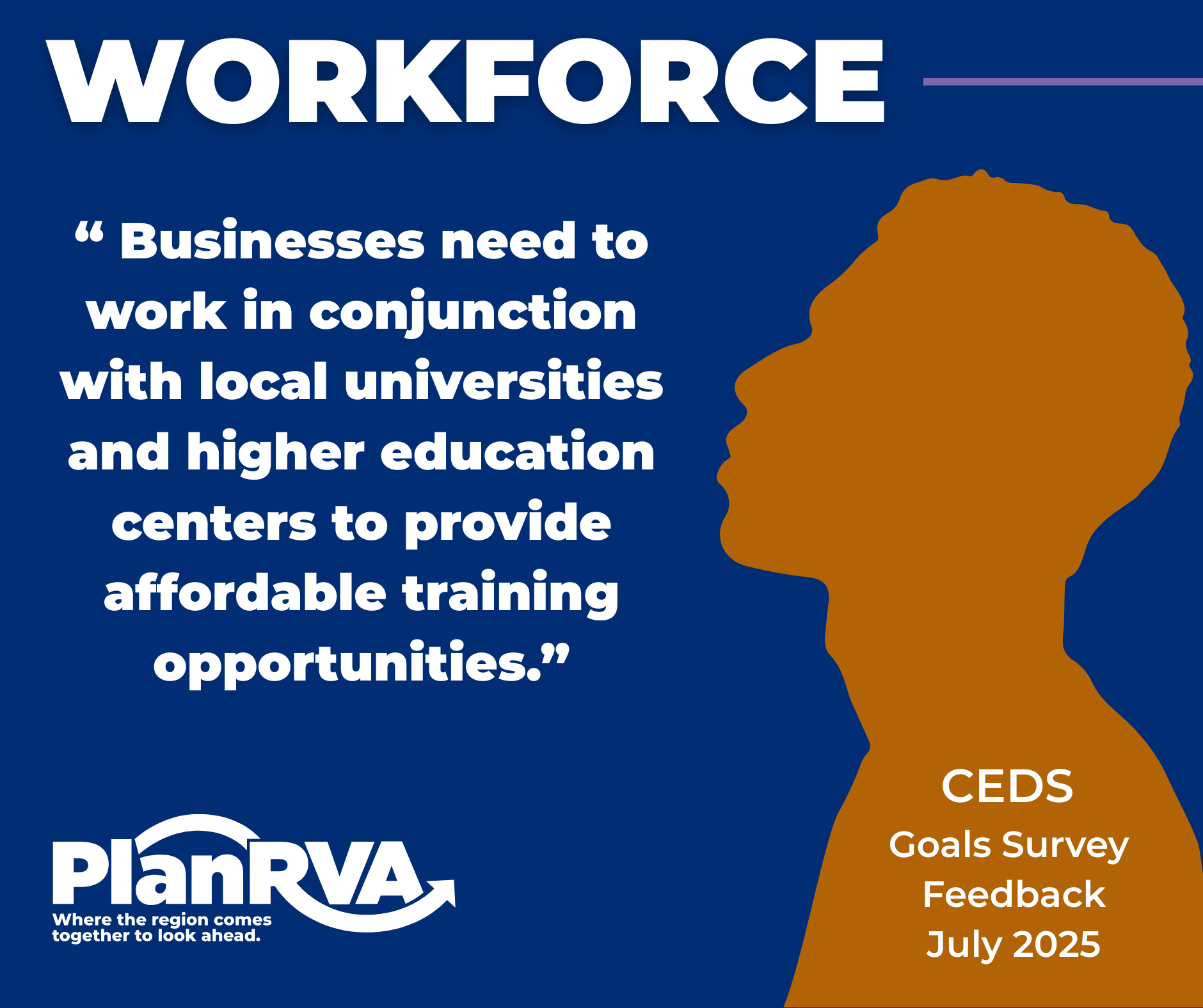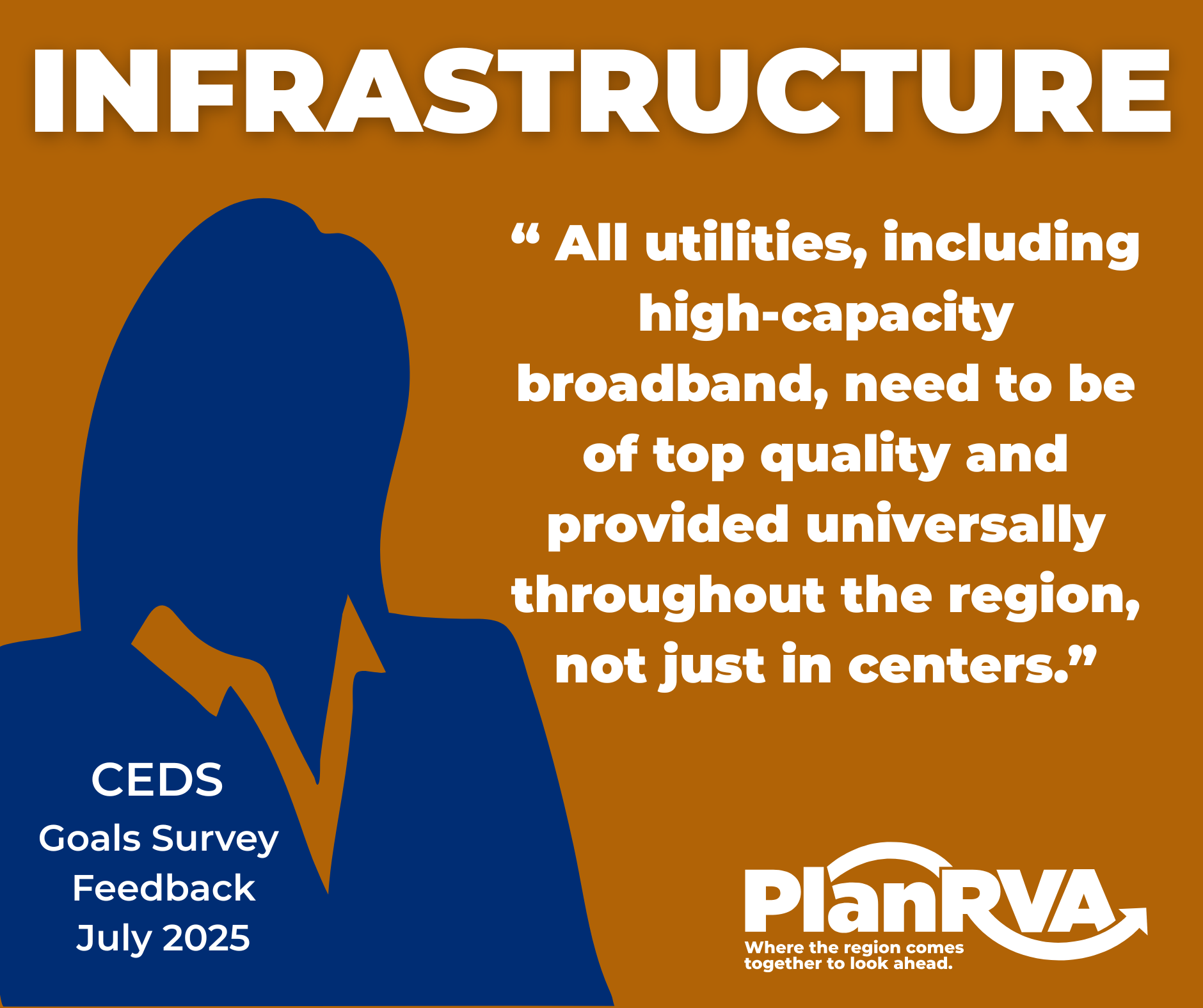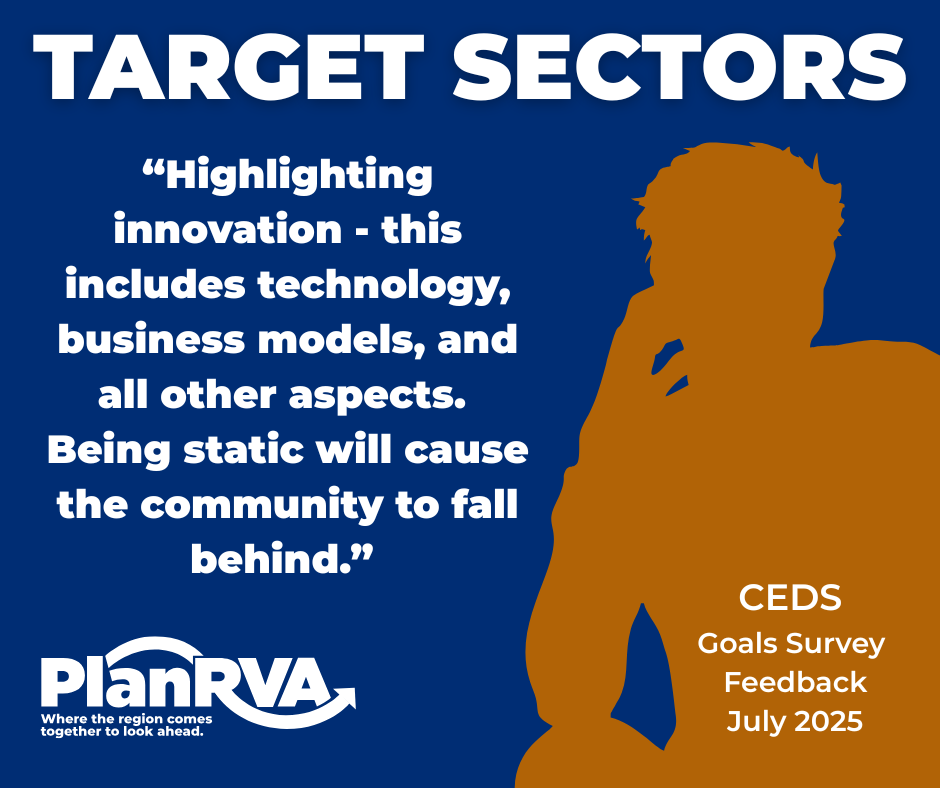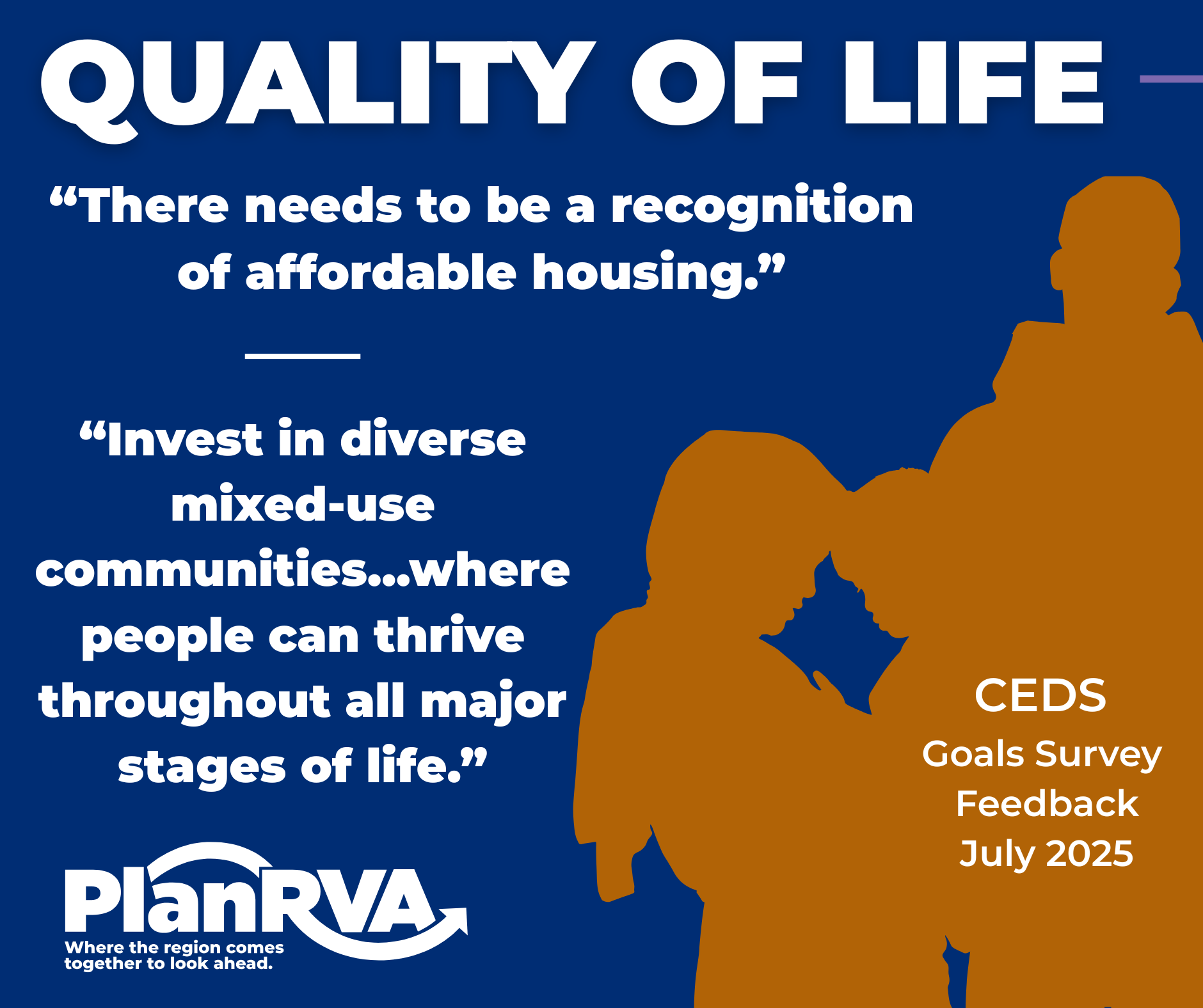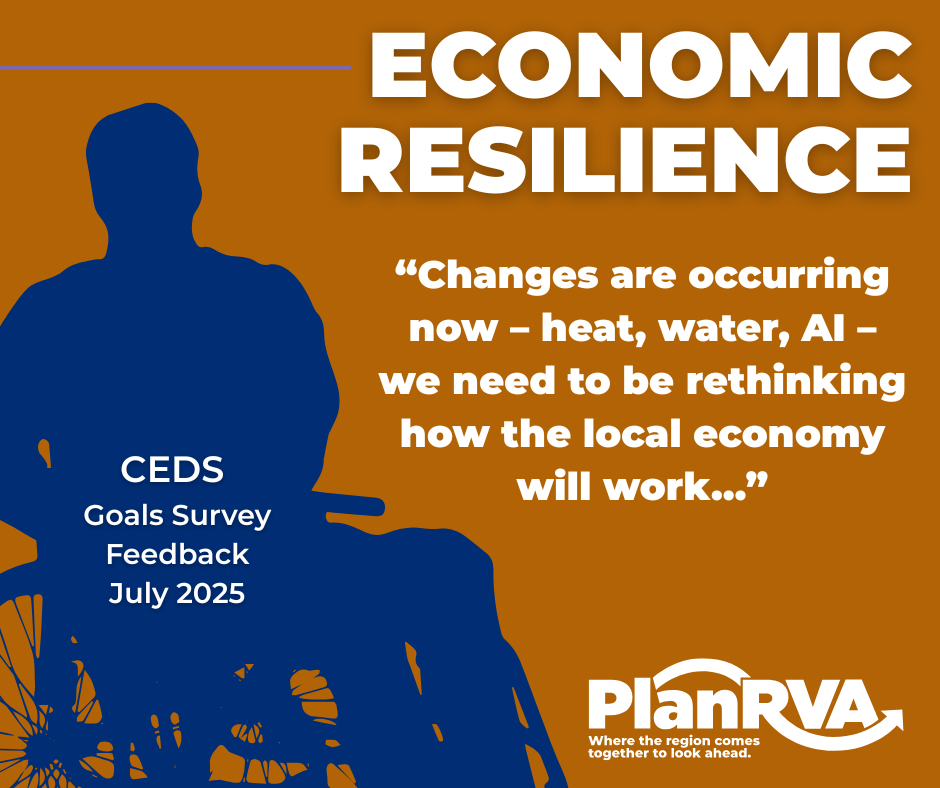Updates
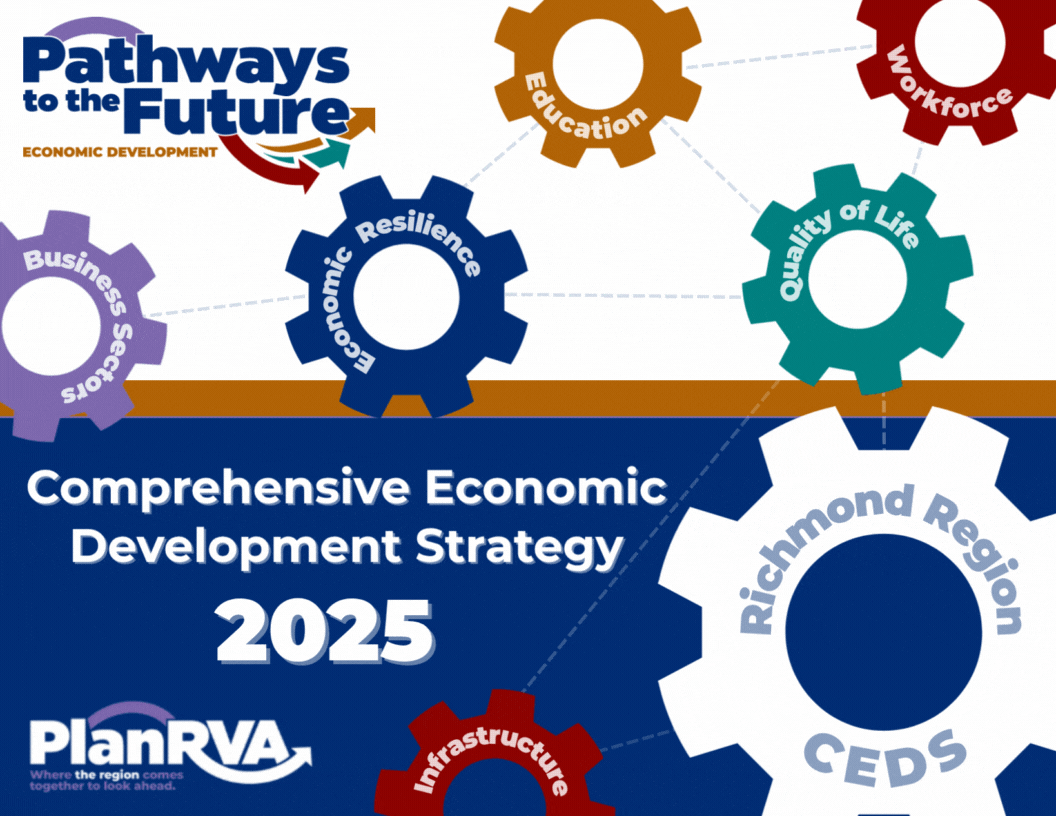
Public Comment
Public Comment is open for the draft of the Final Report until November 8, 2025.
Here are some major parts of the plan we thought you might be interested in.
Click the + to expand and read more.
Comment your thoughts in the box at bottom of the page.
Here we summarize regional conditions like demographics, wages, housing, infrastructure, and more, that inform what our strengths and opportunities are.
We also share targeted industry clusters for employment like Advanced Manufacturing or Information Technology.
The maps in this section show the results of a regional land use and Activity Center analysis.
Activity Centers are existing and forecasted future nodes where concentrations of people work, live, or both. This, plus locality input were used to create a map that shows regional focal areas, as well as additional important economic development areas noted as current or likely nearer-term growth areas – see the map and descriptions below.
These are key areas in the region where we might want to focus investment.
See the Your Input tab on this page for more about what the public told us.
Engagement began with a steering committee comprised of experts in the field.
A total of 747 individuals were engaged at 17 events, with additional engagement that occurred through outreach on social media and via agency newsletters.
You can read more by downloading Appendix C--Community Engagement
Based on data research, public surveys and stakeholder engagement, and the Steering Committee’s understanding of the region. These help inform the Strategic Direction/Action Plan.
Strengths
- Location (Middle of East Coast)
- Quality of Life
- Relatively Lower Cost of Living
- Tourism Assets
- Natural Resources - Green Spaces, Water Resources
- Strong Trade and Export Potential
- Diverse Economic Base, Presence of International Companies
- Diverse Industries
- Business-Friendly Environment
- Entrepreneurial Culture
- Infrastructure – Transportation network, Communications Network, etc.
- Skilled and Educated Workforce
- Access to Capital
- Wide Variety of Higher Education Resources
- Growing Region – Population and Businesses
- Dedicated and Collaborative Organizations and Institutions
- Cultural and Recreational Resources (Music/Art/Restaurant Scene)
- Reckoning with the Region’s Complex History in Thoughtful Ways
- High Uptake of Early Education, Nation-Leading Quality
- Multicultural Region with Resources to Support People and Businesses
Opportunities for Growth or Improvement
- Maintaining and Upgrading Aging Infrastructure
- Continued/Increased Investment in Transportation and Mobility Connections – Domestic Flights, Transit
- Quality, High-Speed Broadband Across the Region
- Energy Supply Growth and Predictability
- Sites/Land: Sites with Infrastructure
- Sites/Land: Publicly Owned/Controlled Sites
- Sites/Land: Small Lot or Flex Space Development
- Rate of Growth in Household Income
- Housing Supply, Across the Spectrum of Unit Type, and Meeting Needs for All Ages
- Attainable Housing for Mid and Lower Median Income Population
- Differing Education Outcomes
- Differing Economic Mobility
- Raising the Region’s Profile Nationally and Globally
- Capitalizing on RVA’s Existing Workforce, Including Older Age Groups
- Attracting Additional Knowledge Workers
- Coordinated Workforce Development System
- Work Based Learning Programs and Career and Technical Education (CTE)
- Additional Access to Venture and Other Capital
- Access to Goods and Services Across the Region
- Rate of Employment Growth
- Natural Hazards Resilience – Businesses Preparedness
- Unmet Demand for Affordable Childcare
Intended to help the region safeguard strengths and address opportunities, here are 6 goals, with strategies of how to achieve them. These are in alignment with the Region's Strategic Plan.
In addition, for each strategy under a goal there are a set of more specific action steps and potential partners.
- Click each colored box image to view a quick overview of the Goal.
- Click the link above each Goal's box to read the complete Goal including Action Steps.
- Or download Full Action Plan.
Read All of Goal 1+Action Steps
Read All of Goal 4+Action Steps
Read All of Goal 5+Action Steps
Read All of Goal 6+Action Steps
This is the set of measurements that would help us determine if we're making progress on the goals.
Click to view images or Download Evaluation Framework
Toolkit
Help us spread the word to share the draft plan and get final input: October 10-November 8, 2025.
-
Sample Text to Share
PDF Flyer (8.5 x 11")
CEDS map image
CEDS Call to Action Image
How to Translate This Page
Español texto de muestra para compartir
Español imagen de llamada a la acción del CEDS
Your Input
What We Heard
The experts we've gathered to work on this project have looked at the data of the existing conditions in our region.
Here's what we were looking for with public input like this:
1) Did the responses from the public (YOU), illuminate some of the same priorities and concerns?
2) Did you bring up anything new that we should explore?
In Stage 1 of the CEDS update:
Input from the public helped the project’s steering committee to consider the region’s areas of strength and opportunities for growth or improvement.
In Stage 2:
The steering committee considered goals and activities that can help the region maintain its strengths or address areas where improvement is needed.
Public feedback shed additional light on these goals, with a variety of perspectives shared. We've chosen a few to spotlight here.
A few things to note:
These are not statistically representative samples--the number of people who answered was relatively small, though we did outreach in all localities during the short survey periods (Survey 1: Feb - March 2025, Survey 2: June - July, 2025)
BUT--we are working with several partners and economic development offices across our region so their input is also being captured in our work. We're basing our outcomes on all of this information together.
Click on the photo boxes for a closer read!
Visualize the Results
See more of the results and methodology.Take a look back at what the Survey 2 asked:
Overview
Project Overview
Economic development includes education, workforce development, community features that attract or retain workers, and infrastructure and land planning.
A Comprehensive Economic Development Strategy (CEDS), includes all these and provides an economic “state of the region” snapshot and develops a roadmap for economic development effort in the region.
How?
Steps include gathering and analyzing relevant data, talking with the community, identifying trends, and creating an action plan and evaluation metrics. The goal is to align economic development efforts across the nine localities.
Who?
The CEDS for the Richmond region is being developed with each local government and business, community, and elected officials at the local, regional and state levels.
Why?
The CEDS will integrate work from across the region, and once completed, can be used to support funding requests in areas such as workforce training, broadband expansion, and infrastructure investments.
A CEDS is required for possible future designation of this region as an economic development district (EDD), which could bring additional resources to Richmond to support economic development planning and projects.
When?
See the Project Timeline at top right for more.
This process updates the last CEDS for the Richmond region, which was adopted in 2014. A copy of the 2014 plan can be found under the Project Documents section of this page.
FAQs
FAQs
A Comprehensive Economic Development Strategy (CEDS) is a regional planning document that provides a strategic roadmap for economic growth and helps in seeking public grants and funding for economic development projects.
The CEDS focuses on issues and recommended actions of regional significance, and does not replace economic development planning or activities undertaken by local governments or other organizations.
This CEDS will form a portion of the regional strategic plan, Pathways to the Future: Economic Development.
The CEDS process is guided by a Steering Committee and will include input from the community and a variety of stakeholders across the region.
We also want to know what YOU think. Visit this page to tell us your thoughts as we have open input periods on the Richmond region's strengths and opportunities for improvement.
Recommended actions in the CEDS may take many years to accomplish, but the plan itself is designed to be refreshed every five years, with progress assessment occurring in the intervening years.
The CEDS update process welcomes community input!
The Your Input tab shares the input timeline and results from public input throughout this period.
Please check back to this page to see any currently open periods of input and/or click "+ Follow" button at the top to be notified as we add substantial news.
The 2014 CEDS is available in the Project Document section of this page. The current process to update the regional CEDS includes revising data and conducting new engagement processes with the community and stakeholders.
Alongside PlanRVA staff, there is a project Steering Committee which will lead the creation of the CEDS. The Committee includes representatives from locality, regional, and state government, as well as a range of other stakeholders from the region.
Contact Us
Have questions or want to learn more about a project, contact us below:
Contact Information Email input@planrva.org Website planrva.org

